Gamelan in New York City
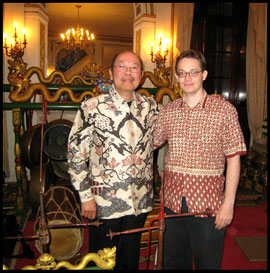
Last weekend Gamelan Kusuma Laras, Directed by I.M. Harjito, played two concerts at the Indonesian Consulate in NYC. Founded in 1983, the concerts marked the group’s 30th anniversary.
If you haven't yet heard traditional Javanese gamelan, it is a wonderful experience. Most of the instruments are made from cast bronze - beautiful to hear as well as to see. They look like variations of xylophone or gongs. The music is is played in cycles with interwoven rhythms, with instruments (in addition to the metal ones, there is one bowed and one flute-like, plus chanting and clapping.
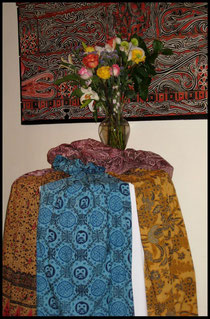
The consulate has a full orchestra of instruments which the players used for this concert. The event was held in rooms decorated with art and artifacts from Indonesia. And there were delicious Indonesian snacks laid out for the intermission! For those of us who are interested in batik, it was a great opportunity to see the traditional fabric being worn by many of the musicians and the consular staff. And the tables were adorned with cloths as well. The event was truly a feast for all the senses.
The Director General and his wife were extremely gracious in hosting the event. In addition the consulate is arranging several upcoming events for 2014 -- one to promote batik! As soon as we learn more, we will post the information here on the blog. To learn more about Gamelan Kusuma Laras, click here.
Danar Hadi Batik Museum
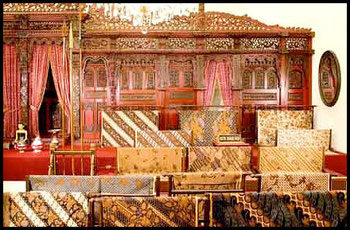
All the excitement surrounding the Interwoven Global exhibit at the Metropolitan Museum in NYC reminded me of another great (permanent) exhibit - where the textiles are an expression of the cultural influences in just one country over time.
I'm thinking about the terrific Danar Hadi Antique Batik Museum in Solo, Indonesia. The museum is part of a complex that includes a showroom and a workshop. In 11 rooms the museum showcases roughly 600 pieces of batik selected from the family's 10,000+ piece collection. In their own words:
This combines various types of batiks collected by Mr. H. Santosa since 1967, and also his ancestral collections, including that of his great grandfather H. Bakri (first generation); collection R.H.S. Wongsodinomo (second generation), his grandfather; and the collection of H. Hadiprijana, the parent of Ibu Hj. D. Santosa.
For a short description of the Dutch, Chinese, Indonesian, Palace and Danar Hadi batiks, click on each of the images on this page:
http://www.houseofdanarhadi.com/en/batikdanarhadi.php
For those interested in the batik making process:
http://www.houseofdanarhadi.com/workshop.php
For armchair travelers, enjoy this excellent description of the experience:
http://www.travelsinparadise.com/travelarticle/batik-museum.html
Museum admission
includes a guide (in my case in English). He was great: An excellent communicator and very knowledgeable about the history, the collection and the process. So if you can swing
it -- it's really worth a trip to the Danar Hadi complex.
Holiday Ornaments are Here

October was a busy month working on the final designs for our collection of Indonesian batik-inspired ceramic holiday ornaments. And making plans for our pop up shop for the holidays. Now the ornaments are here, and we hope you love them. All design elements come from textiles on hand. The stars, leaves, hearts and flowers have been updated with bright modern, and in some cases surprisingly dramatic colors to fit the season. All are about 3" rounds with a high gloss. Made in the USA. Coming soon, mugs! Looking forward to a bright holiday season.
Indonesia Celebrates Batik Day
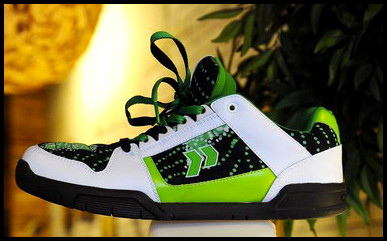
Always fun to see how Indonesian fashion designers apply batik in a modern context. Designer Embran Nawawi launched his Precise Batik Shoes collection to coincide with National Batik Day on October 2.
Giving Back - 1% for the Planet

When I started Textiil, I knew I wanted to raise awareness of the rich textile traditions from Malaysia and Indonesia, to help broaden the market for the cloth and to provide income to the
artisans and business people involved in the making and selling of the cloth. In addition, to engage and employ people here in the US for additional product components and
craftsmanship. As I source my batik, one of the challenges has been sourcing "clean" batik. Slowly I am pulling together a group of individuals and companies using natural
dyes, and/or filtering the water from the dying process. I'm definitely making headway, but the pace of change is a little bit slow! So I am very happy to announce that Textiil has
joined the community at 1% for the Planet. Our contribution will support three organizations: Cityseed in New
Haven, CT, the Malaysia Nature Society, and East Bali Poverty Project. Done! (And well in advance of the holidays -- when we'll introduce a line of ornaments and mugs based on
design cues from some of our favorite batiks). Learn more about how 1% for the Planet members have contributed over 100 million dollars to sustainability initiatives!
Pillows - Refreshing!

Yesterday, my friend Karen was choosing new pillows for her guest bedroom. She really liked two very different pillows -- which reminded me of a great little slideshow on House Beautiful titled "1 Sofa, 6 Different Looks." Changing your pillows is a fun, and relatively inexpensive way to refresh a room. A large neutral sofa and relatively soft neutral bedding colors provides the perfect setting -- she really can change the look and feel of the room by simply changing her pillows. For herself and her guests, her favorites are the bright, bold orange and red stripe batik pillows in the photo. But when her son comes home, she'll revert back to a calm, crisp and modern look with blue and green clouds on a natural background. (I love pillows).
Go --> Asian Textiles in NY and LA
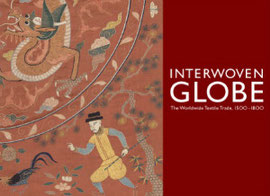
As summer transitions to fall, it's always a pleasure to see what the upcoming museum season will offer. Here are two noteworthy exhibits that featuring textiles from Asia:
In New York, at the Metropolitan Museum of Art, Interwoven Globe: The Worldwide Textile Trade, 1500-1800. Using textiles from the Museum's collection plus international loans, the exhibit will explore the impact and influence on designs, processes, materials and aesthetics as evidenced through the trade routes between Europe and Asia, and eventually to the Americas from "the golden age of European exploration."
Beginning September 15th, UCLA's Fowler Museum presents Fowler in Focus: Fiftieth Anniversary Gifts within the Intersections: World Arts, Local Lives long term exhibit. Featuring milestone anniversary gifts to the Fowler, the first installation will focus on art from Asia with an emphasis on textiles -- and will include pieces from both Indonesia and Malaysia.
Tell us if there is an upcoming exhibit you'd like us to write about.
Fair Trade and Clean Batik Suppliers

Rachel Biel, the dynamic founder of the TAFA List, (a vibrant community of nearly 500 fiber artists, designers, and businesses) recently wrote in support of Fair Trade organizations and initiatives in the TAFA member blog. Coincidentally I’ve been thinking a lot about my friend Novi, founder of Java Ixora, a member of the WFTO Asia. Last year I spent half a day plus a car ride from Yogjakarta to Solo learning about her business, and meeting the young people she was training and mentoring at that time. I am hoping to receive some unique textiles from her again soon as she works to support Indonesian craftspeople from her base in Yogjakarta. In the meantime, please see the “Bama” ikat pillows made from ikat she supplied. Novi maintains that President Obama wore an ikat with this pattern at some point during his visit to Indonesia in 2011! Not so sure about that but here he is wearing a totally, different but great looking shirt. More on socially conscious suppliers in a forthcoming post when we take a brief look at Clean Batik.
Symbols --> The Garuda, Myth and Meaning

You will often find a mix of flora and fauna in the Indonesian batiks motifs. Our newest pillow features peacocks and leafy vines -- but roosters, peacocks, and other fanciful birds are plentiful. The most majestic of the birds is the storied Garuda. A powerful eagle-like animal from buddhist and hindu mythologies, this creature serves as the symbol of the nation and the namesake of the Indonesian national airline. The Embassy web site explains the meaning of the 8 tail feathers, 17 wing feathers, and 45 feathers on the neck signifying the date August 17, 1945 -- the date Indonesia declared independence from the Netherlands.
Batik --> On Wood

Many people are quite familar with fabric batik, but the first time we saw a display of wood batik it really made an impression. Masks are one of the more popular items created with wood batik in Indonesia, but we found wonderful trays, bowls and a great selection of wooden pencils when a group of Indonesian artisans came to Kuala Lumpur on a trade mission. The general process seems to be quite similar to batik on fabric, but the detailed explanation here, suggests additional complexity in working with wood. On my next visit to Yogjakarta I plan to explore more about the process of batik on wood.
Batik Motif --> Parang, A Royal Past

The parang, or sword motif of Central Java was traditionally meant to be worn only by the royal family. The pattern was designed to signify power, but the highly regarded Winotosastro batik makers say that the parang rusak motif also displayed the triumph of wisdom and nobility over earthly desires.
One will find many, many versions of parang pattern from small to large, but I like the feel of the large patterned piece from Cirebon, (pictured here). It looks great as a hanging panel.
Large or small, the parang rusak will always have the continuous wavy pattern, always on the diagonal. See another example of batik rusak from the Australian Museum collection.
More --> About Songket
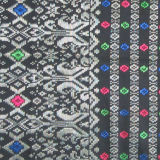
Last week we took a brief look at the introduction of songket to Malaysia and Yayasan Tuanku Nur Zahirah, an organization working to preserve this woven art with training and support for the weavers, along with with modernizing motifs and applications.
This week we’ll look at the family-owned business Bibah Songket. Habibah Zikri is the award winning lead designer who got her start with Kraftangan and went on to create her own thriving business. Habibah’s husband also worked with Kraftangan (Malaysia’s government organization overseeing craft development and promotion) for many years. Their daughter Sabrina is now the business manager based in Kuala Lumpur.
I had the pleasure of meeting with the family in their Kuala Lumpur showroom and talking with them about their work and their efforts to find a wider audience for their stunning songket products. (Protective of her unique designs, the image shown is from my collection – it is not a Bibah songket). At Bibah Songket they pay their weavers a monthly salary, not per piece nor commission on goods sold. You can learn much more about the history, design structure, and motifs of Malaysian songket at the Bibah Songket web site.
Good to Know --> Malaysian Songket

Songket is a beautiful woven textile from the brocade family. It is most often made from cotton or silk with a portion of the motif woven in metallic threads. Traditionally, this luxurious fabric was used for costumes on ceremonial occasions.
Scholars are still debating where the craft originated, with evidence of Chinese, Indian, and Cambodian influences found in the materials, motifs and process. It is believed that the textile has been part of Malay culture since the 15th century.
To ensure that the tradition of songket weaving survives, the queen of Malaysia established a foundation to support weavers with training and to provide the weavers they work with a liveable wage. Read about YTNZ and learn more about Royal Terengganu Songket.
Our first tablerunners are made from songket from a small business in Terengganu. We selected a simple geometric Bunga Dalam (Flowers Within) motif. The runners add wonderful color to your table and work well with simpler patterned plates.
Y8JJMUU59ECB
Read All About It --> Eyes of the Ancestors

One of the premiere collections of Indonesian traditional arts can be found at the Dallas Museum of Art. This summer look for "Eyes of the Ancestors" from Yale University Press, a book of photography and essays by international scholars exploring a selection from the Museum’s collection of textiles and arts from the islands of Indonesia, Sarawak, and East Timor.
What I’m reading now: Batik - 75 Selected Masterpieces (The Rudolf G. Smend Collection). Essays, textiles, and photos along with a basic, useful glossary. The images are beautiful, including a great example of the European-influenced batik sarong -- illustrating the fairy tale Cinderella! See another example of a fairy tale batik and read about it here.
Good to Know --> Kraton by Auguste Soesastro

On April 18th, FIT hosted "Preserving Asian Culture through Fashion and Textiles." One of the truly beautiful collections featured was Kraton, by the Indonesian designer Auguste Soesatro. He is using some of the fabrics from Cita Tenun Indonesia - a group seeking to provide resources and training to weavers in various parts of Indonesia - in the hope that the the weavers can increase their productivity and reach a broader market. The clothing and the textiles are stunning. Hopefully in the near future you will see the collection here.
Go --> Washington DC Textile Museum

April in Washington DC is just beautiful - the cherry blossoms were a very welcome sign that spring is at last, really here. The final exhibit at the Textile Museum in its current location is: Out of Southeast Asia: Art that Sustains. Historical textiles from the collection along with wonderful contemporary works by batik artists Nia Fliam, Agus Ismoyo, and Vernal Bogren Swift, and weaver Carol Cassidy. If you are in the area --> Go!
The Textile Museum will close in October to relocate and reopen in fall 2014.
